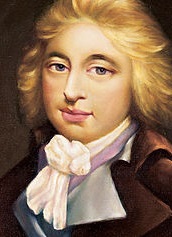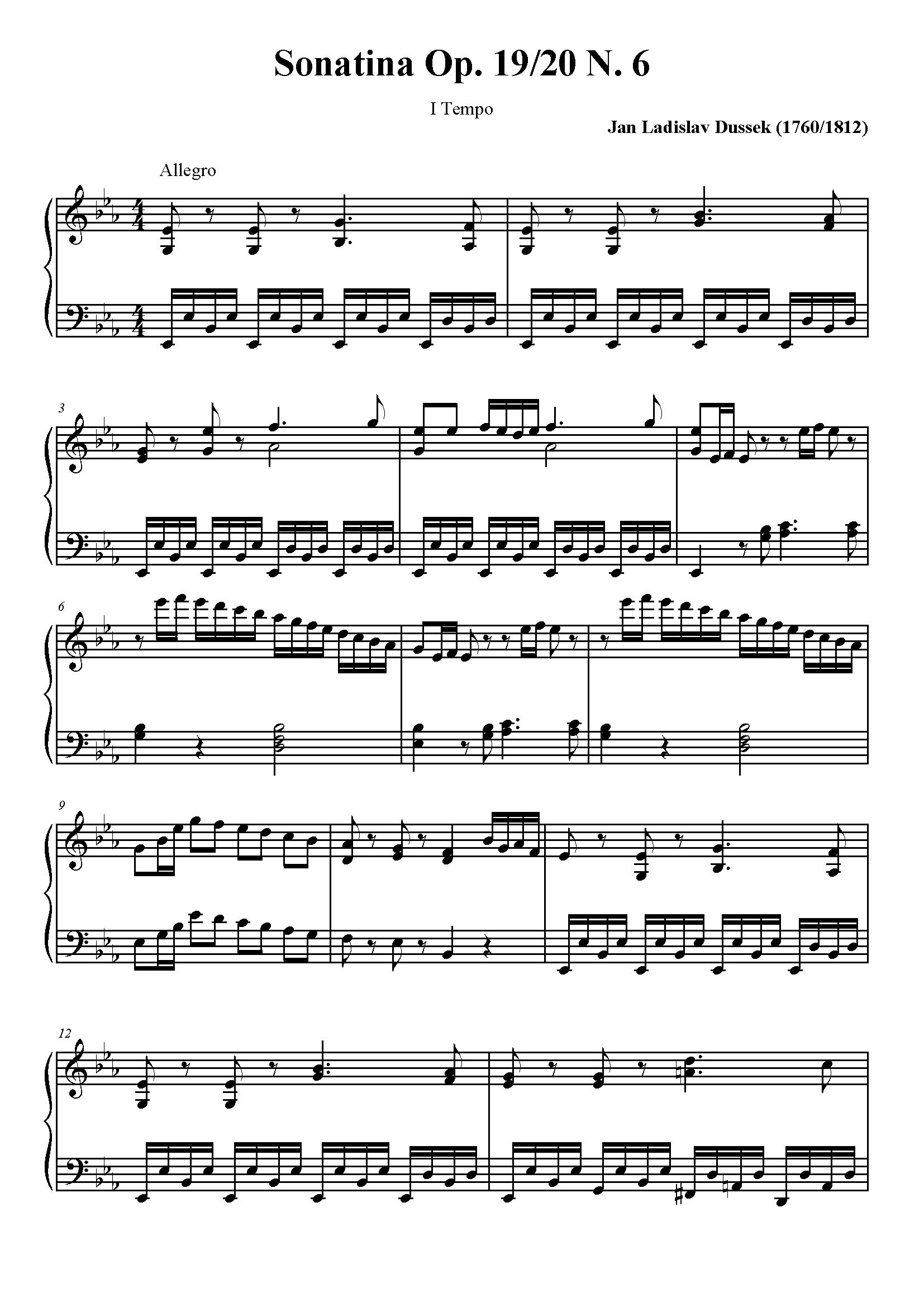Sonatina Op. 19/20 n. 6

Dussek, Jan Ladislav (1760 - 1812)
Sonatina in E-flat Maj. Op. 19 / 20 n. 6
| Sonatina in E-flat Maj. Op. 19 / 20 n. 6 | |||||
| Piano: Tullio Forlenza |
|||||
|
You can purchase these recordings in HD quality (192.000 Hz 24 bit) |
|||||
 |
|||||
To consult different editions of this work go to:
JAN LADISLAV DUSSEK - 6 Sonatinas for Piano, Op. 19 / 20 - IMSLP
CENNI STORICI
This Sonatina in E-flat Maj. Op. 19 / 20 is the sixth of a group of six sonatinas, originally written for piano with flute accompaniment, published in 1793 in London by Longman & Broderip.
CHARACTERISTICS OF THE PIECE
The Sonatina in E-flat Maj. Op. 19 / 20 n. 6 consists of two Movements:
1° Mov.: Allegro
2° Mov.: Rondò. Allegretto
The first movement of this Sonatina differs from the previous sonatinas due to its greater breadth and to a richer variety of musical elements. In this case the two parts, which make up the first movement are also both repeated, as often happened in the Sonatinas in this cycle.
The first thematic block opens with an initial phrase rather rhythmical in character, followed by a short motif, here presented with some scales, which is repeated several times during the piece, each time with different expressive functions.
The presentation of these elements ends with a brief closure in the dominant key preparing for the repetition of the first phrase which, unlike the beginning, also ends this time round in the dominant key.
Next comes the short motif that now assumes greater importance and which, with a phrase built entirely on it, leads to a new suspension on the dominant key, thus making way for the entrance of the second thematic section, replete with melodic and rhythmic figures and which re-proposes the same motif that had already been presented in the first thematic group but with new features.
The entire first part is then presented as a refrain.
The recapitulation section opens with the return of the first initial theme that is not repeated immediately but utilised as a coda at the end of the piece. Within it the motif that has already appeared several times, links the first thematic group to a modified version of the second thematic group but, as tradition dictates, it is now in the initial key.
The second part is also repeated in its entirety.
AI B1I AII B1II CI AII mod short B2I mod AIV short CII AVmod short B2II mod AVI short
The second movement is an Allegretto in the form of a Rondo. The main theme is melodic in character and is repeated twice with a refrain, followed by a very short and fluid first episode and, without wandering too far from the original key, links to a new repetition of the initial episode.
A new pleasing episode then appears in the subdominant key which, inspired by a simple melodic phrase, becomes more urgent with the use of a tighter accompaniment. A new melodic phrase concludes this more extended episode and a playful link brings us back to the first episode.
A variant of the second episode follows, introducing a new version of the original theme transposed to the upper octave with a series of short suspended cadences, which gradually leads to the conclusion of the piece:
AI BI AII CI AIII BII mod AIV var prol
PERFORMANCE NOTES
From both a performance and an interpretative point of view, the last Sonatina of this Opus should be considered a miniature Sonata, due to its thematic variety and to a greater complexity in its phrasing and expression.
Moments of internal quiescence are more evident from the point of view of its musical flow, with expressive cadences and different musical characters being offered to the listener .
In the first movement the expressive intention was one of balancing elegance, of giving "nobility" to its phrasing and expression with greater sensitivity to the dynamics.
In terms of its thematic formulation, the second movement brings to mind the experiments in the early Beethoven Rondo. Such inspiration is already visible in the initial episode where it immediately shows a longing for chamber music, easily recognizable by the rapid separating of the musical lines that pass from two to four within the space of a few bars.
The successive episodes of the Rondo happily alternate more flowing moments with melodic parts interspersed with more amusing and joyous moments used as an interlude between the different sections.
This type of writing always requires that the performer possess the ability to pass quickly from one expressive character to another and then to carefully control the change of timbre.
The most interesting part of the Rondo is the final page, in which the elements presented seem to be rarefied and slow down until they reach a conclusion of unexpected simplicity, as if highlighting the composer’s modesty who then discreetly withdraws in the last line after having gifted us this interesting series of pieces.
In order to create this final atmosphere, a great deal of attention to the enhancement and framing of each individual element was required, so as to insert it in this predefined and expressive design.
In conclusion, this Sonatina is undoubtedly of great musical interest in that it gives students an opportunity to grapple with more mature expressive and functional aspects of their growth in relation to a more advanced repertoire.
Tullio Forlenza
(Trad.: Sara Rosenman)
